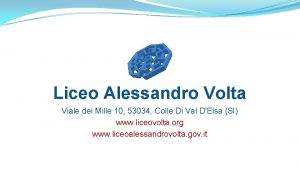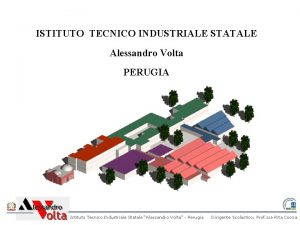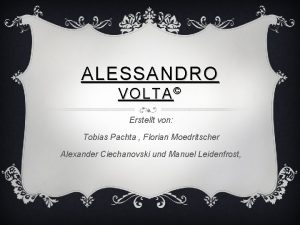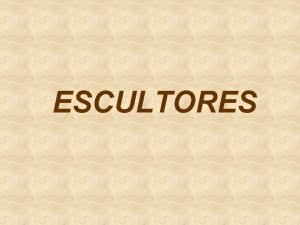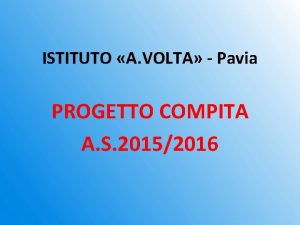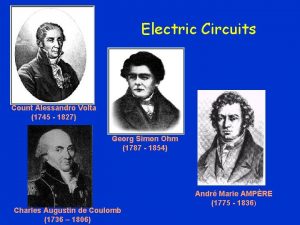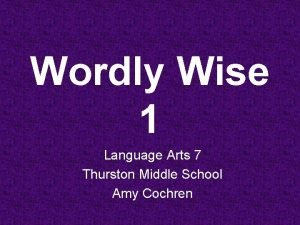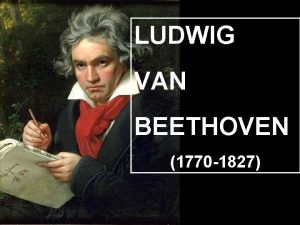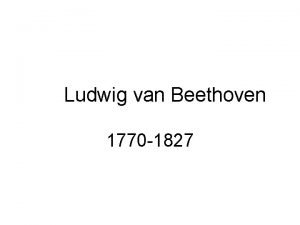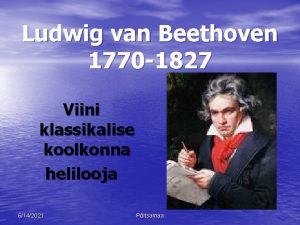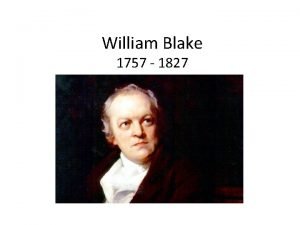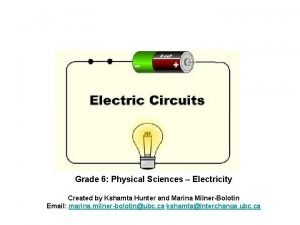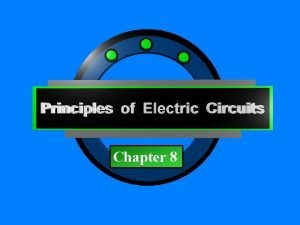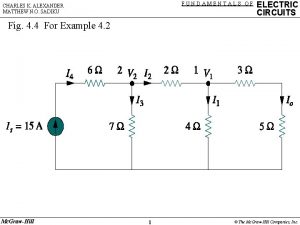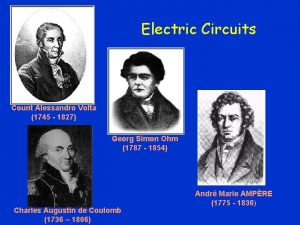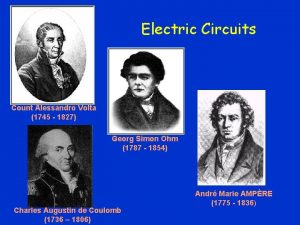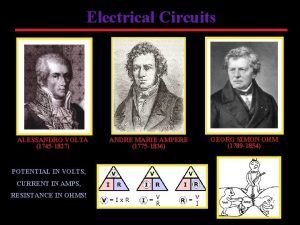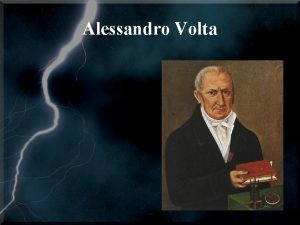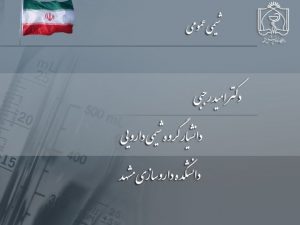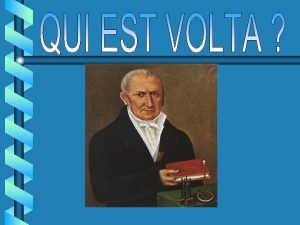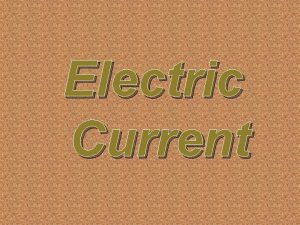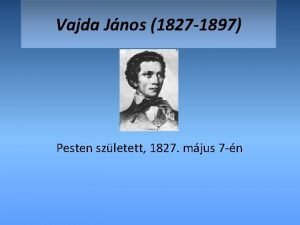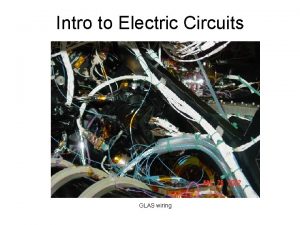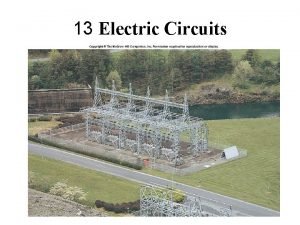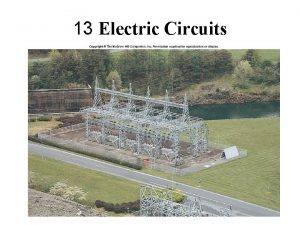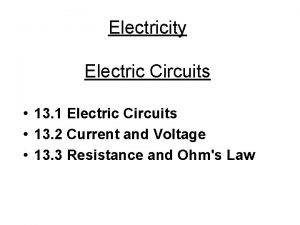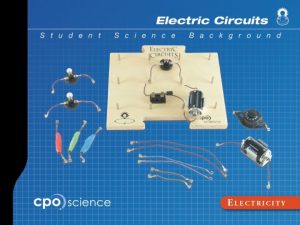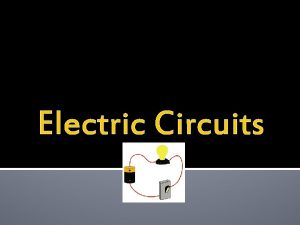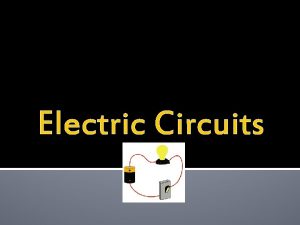Electric Circuits Count Alessandro Volta 1745 1827 Georg























- Slides: 23

Electric Circuits Count Alessandro Volta (1745 - 1827) Georg Simon Ohm (1787 - 1854) Charles Augustin de Coulomb (1736 – 1806) André Marie AMPÈRE (1775 - 1836)

Simple Electric Cell Carbon Electrode (+) wire + + + _ _ _ Zn Electrode (-) Zn+ Zn+ Sulfuric acid • Two dissimilar metals or carbon rods in acid • Zn+ ions enter acid leaving terminal negative • Electrons leave carbon leaving it positive • Terminals connected to external circuit • ‘Battery’ referred to several cells originally

Electric Current Electrons flow out of the negative terminal and toward the positive terminal electric current. (We will consider conventional current – positive charges move Electric current I is defined as the rate at which charge flows past a given point per unit time. 1 C/s = 1 A (ampere)

Electric Circuit • It is necessary to have a complete circuit in order for current to flow. • The symbol for a battery in a circuit diagram is: “Conventional” current _ + direction is opposite to actual electron flow direction which is – to +. Current Device 9 volts +

Ohm’s Law • For wires and other circuit devices, the current is proportional to the voltage applied to its ends: I V • The current also depends on the amount of resistance that the wire offers to the electrons for a given voltage V. • We define a quantity called resistance R such that • (Ohm’s Law) • The unit of resistance is the ohm which is represented by the Greek capital omega ( ).

Resistors • A resistor is a circuit device that has a fixed resistance. Resistor Code Calculator Resistor Code Resistor Circuit symbol Resistors obey Ohm’s law but not all circuit devices do. I I 0 Resistor V 0 V non-ohmic device

Ohm’s Law • Demo: • Vary applied voltage V. I R I • Measure current I • Does ratio constant? V V remain slope = R How to calculate the resistance? Include “resistivity” of material I Include geometry of resistor

Resistance • Resistance is defined to be the ratio of the applied voltage to the current passing through. I R I V UNIT: OHM = W • Increase the length flow of electrons impeded • Increase the cross sectional area flow facilitated • Compare to straws or pipes

Two cylindrical resistors are made from the same material, and they are equal in length. The first resistor has diameter d, and the second resistor has diameter 2 d. 1) Compare the resistance of the two cylinders. a) R 1 > R 2 b) R 1 = R 2 c) R 1 < R 2 2) If the same current flows through both resistors, compare the average velocities of the electrons in the two resistors: a) v 1 > v 2 b) v 1 = v 2 c) v 1 < v 2

Strain Gauge • A very thin metal wire patterned as shown is bonded to some structure. • As the structure is deformed slightly, this stretches the wire (slightly). – When this happens, the resistance of the wire: (a) decreases (b) increases (c) stays the same Because the wire is slightly longer, is slightly increased. Also, because the overall volume of the wire is ~constant, increasing the length decreases the area A, which also increases the resistance. By carefully measuring the change in resistance, the strain in the structure may be determined.

Power in Electric Circuits • Electrical circuits can transmit and consume energy. • When a charge Q moves through a potential difference V, the energy transferred is QV. • Power is energy/time and thus:

Notes on Power • The formula for power applies to devices that provide power such as a battery as well as to devices that consume or dissipate power such as resistors, light bulbs and electric motors. • The formula for power can be combined with Ohm’s Law to give other versions:

Household Power • Electric companies usually bill by the kilowatthour (k. Wh. ) which is the energy consumed by using 1. 0 k. W for one hour. • Thus a 100 W light bulb could burn for 10 hours and consume 1. 0 k. Wh. • Electric circuits in a building are protected by a fuse or circuit breaker which shuts down the electricity in the circuit if the current exceeds a certain value. This prevents the wires from heating up when carrying too much current.

The Voltage “drops”: Resistors in Series I a R 1 b R 2 Whenever devices are in SERIES, the current is the same through both ! a This reduces the circuit to: Hence: c Reffective c

Voltage Divider Two resistors are connected in series to a battery with emf E. The resistances are such that R 1 = 2 R 2. Compare the current through R 1 with the current through R 2: a) I 1 > I 2 b) I 1 = I 2 c) I 1 < I 2 What is the potential difference across R 2? a) V 2 = E b) V 2 = 1/2 E c) V 2 = 1/3 E

Resistors in Parallel • What to do? • Very generally, devices in parallel have the same voltage drop • But current through R 1 is not I ! Call it I 1. Similarly, R 2 «I 2. KVL Þ a V Þ Þ I 1 I 2 R 1 R 2 I d I a • How is I related to I 1 & I 2 ? Current is conserved! I V R d I

Circuit Practice • Consider the circuit shown: 1 a – What is the relation between Va -Vd and Va -Vc ? (a) (Va -Vd) < (Va -Vc) (b) (Va -Vd) = (Va -Vc) (Va -Vd) > (Va -Vc) 1 B 2 50 W b 12 V (b) I 1 = I 2 20 W 80 W d – What is the relation between I 1 and I 2? (a) I 1 < I 2 I 1 (c) I 1 > I 2 c

Circuit Practice • Consider the circuit shown: 1 50 W a – What is the relation between Va -Vd and Va -Vc ? (a) (Va -Vd) < (Va -Vc) (b) (Va -Vd) = (Va -Vc) (Va -Vd) > (Va -Vc) • Point d and c are the same, electrically b I 2 I 1 12 V 20 W 80 W d c

Circuit Practice • Consider the circuit shown: 50 W a – What is the relation between Va -Vd and Va -Vc ? b 12 V (a) (Va -Vd) < (Va -Vc) (b) (Va -Vd) = (Va -Vc) (Va -Vd) > (Va -Vc) 2 • Note that: Vb -Vd • Therefore, (b) I 1 = I 2 = Vb -Vc 20 W 80 W d – What is the relation between I 1 and I 2? (a) I 1 < I 2 I 1 (c) I 1 > I 2 c

Summary of Simple Circuits • Resistors in series: Current thru is same; • Resistors Voltage drop across is IRi in parallel: Voltage drop across is same; Current thru is V/Ri

Two identical light bulbs are represented by the resistors R 2 & R 3 (R 2 = R 3 ). The switch S is initially open. If switch S is closed, what happens to the brightness of the bulb R 2? a) It increases b) It decreases c) It doesn’t change What happens to the current I, after the switch is closed ? a) Iafter = 1/2 Ibefore b) Iafter = Ibefore c) Iafter = 2 Ibefore


 Liceo a volta colle
Liceo a volta colle Moodle itts volta pg
Moodle itts volta pg Liceo scientifico volta rc
Liceo scientifico volta rc Volta pistole
Volta pistole Cuando murio alessandro volta
Cuando murio alessandro volta Voltov stĺp
Voltov stĺp Liceo artistico alessandro volta pavia
Liceo artistico alessandro volta pavia Alessandro volta formula
Alessandro volta formula Liceo scientifico volta castel san giovanni
Liceo scientifico volta castel san giovanni How did alessandro volta invent the battery
How did alessandro volta invent the battery How many cherokees died of smallpox in 1745
How many cherokees died of smallpox in 1745 (877)415-1745
(877)415-1745 Beethoven was born
Beethoven was born 1770 1827
1770 1827 Did you notice something
Did you notice something 1770-1827
1770-1827 Complementary opposites blake
Complementary opposites blake Current in a parallel circuit
Current in a parallel circuit Electric circuits grade 6
Electric circuits grade 6 Ise fundamentals of electric circuits
Ise fundamentals of electric circuits 9
9 The circuit chapter 8 summary
The circuit chapter 8 summary Chapter 35 electric circuits answers
Chapter 35 electric circuits answers Fundamentals of electric circuits
Fundamentals of electric circuits
